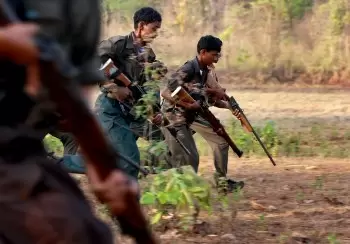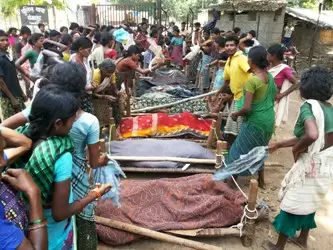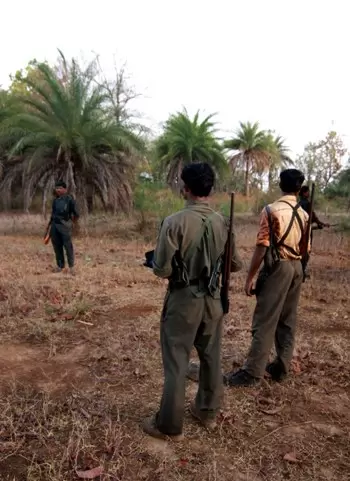All you need to know about Maoist Violence in India

06-November-2014

Pre-Independence West Bengal which gave birth to the Indian National Congress and produced some of the finest freedom fighters also gave birth to the Naxalite movement with its violent manifestations and alien ideology.
While one may not agree with the political ideology of Charu Mazumdar, he certainly succeeded in highlighting the social discrimination and economic disparities in the country.
 |
|
An undated photo of members of Communist Party of India (Maoist) somewhere in Chhattisgarh (Photo: Indian Photo Agency)
|
Countering Naxalism with Development: Challenges of Social Justice and State Security (Edited by Santosh Mehrotra, Sage Publications) is a compilation of background papers produced by an expert group of profoundly knowledgeable and experienced persons.
In Maoism, Democracy and Globalisation (Sage Publications), Ajay Gudavarthy, an academic, highlights the limits of poor people’s opposition to State power and the deficiencies of our political regimes.
The claim of the authorities that Maoism is losing ground, especially in the tribal areas, is not borne out by either of the two books. What is discernable, however, is a change of heart of the leaders of the movement, from mindless killings by their guerilla squads to a more humane approach.
Notwithstanding statutory enactments and institutional mechanisms brought out by the government to address various aspects of deprivation, mere survival is still the basic problem for a large section of the population.
Soon after Independence the government launched land reform measures which included abolition of the zamindari system, security of tenancy and a ceiling on agricultural holdings so that surplus land could be distributed to the landless. As time passed commitment to land reforms weakened and it remains an unfinished task.
The poor had depended on common resources such as forests, pastures and water resources. With increasing tendency to convert such resources as sources of profit by the government, the poor are being deprived of access to these resources and thereby created a situation for the spread of Maoism.
The hawks in the government call it the greatest threat to internal security and want to put it down with an iron hand.
Maoist violence, however, is the manifestation of a deeper social malaise as a result of the collapse of good governance and the intrusion of commercial interest into corporate bodies in the tribal domain.
The tribal people, who account for 8.2 per cent of the population, are found in all States except Punjab, Haryana, Delhi and the Union Territories of Pondicherry and Chandigarh.
The Constitution contains several provisions for ensuring a better quality of life for them based on a policy of affirmative action on the developmental as well as regulatory aspects. Even after 67 years of Independence these provisions are not implemented fully.
In the chapter on “The Factors Underlying Tribal Unrest,” SR Sankaran, IAS, points out that the Governors, in spite of special powers conferred on them, have failed miserably to exercise them.
Tribal unrest of course is not a post-Independence phenomenon. It dates back to the closing decades of the 18th century following colonial expansion into the forests.
Since the beginning of this millennium a new stage of expropriation has begun with mining and industrial projects getting precedence over tribal rights and welfare. This has given rise to various tribal movements, often political in nature but having distinct social, economic and cultural roots. Unrest seems to be the only thing the government takes note of, says the author.
Sukhadeo Thorat and Sandeep Sharma in a chapter on Extremism trace the roots of unrest to extreme poverty and deprivation. “The ultimate reason lies in the violent reaction by the high castes and classes and the inability of the State machinery to deliver justice leading people to lose faith in the institutions of justice and search for alternative solutions.”
Prakash Singh and Ajit K Doval examine the security scenario and, as seasoned police and intelligence officers, give a reflective account of both security and development challenges in the Left-wing extremism affected districts.
SAGE Publications has done yeoman service in undertaking to publish the reports of the Expert Group in a book form whose value would only increase with the passage of time as the authorities continue to fumble with this unceasing problem of unrest.
Ajay Gudavarthy in his book Maoism, Democracy and Globalisation explores the areas of conflict and the pulls they bring to contemporary politics in India. Though the Naxalbari insurrection was quelled in just 72 days, it has remained unflinchingly inspirational for many an experiment in revolutionary political mobilisation.
Maoist politics have since focused on guerrilla warfare and area-wise seizure of power as propounded by Mao.
When the United Progressive Alliance was in power, Prime Minister Manmohan Singh declared that Maoists were the “single largest internal security threat.” But the Scheduled Tribes and Other Traditional Forest Dwellers (Recognition of Forest Rights) Act, 2006, which came into force on 1 January 2008, was never implemented faithfully.
 |
|
Eight villagers, including children, were killed when security forces opened fire suspecting them to be Maoists during a village farm festival at Edakmetta in Bijapur district in Chhattisgarh on May 19, 2013 (Photo by Ganesh Mishra/ Indian Photo Agency)
|
As tribal areas are rich in mineral resources, the mining projects proposed such as in Orissa, Jharkhand and Chhattisgarh threaten the very existence of tribal people and protest action becomes an inevitable consequence of displacement.
The policy of the governments to control the spread of Maoism, both at the Centre and in the States, continues to be extremely repressive, including extra-judicial killings. Nevertheless, the Maoist movement has spread wider than the Communist movement, but it is confined to the most backward forest areas. It has negligible presence in the rural plains and hardly any in the urban centers.
A 2006 “Status Paper on the Naxal Problem” of the Union Ministry of Home Affairs identified the Salva Judum as a “spontaneous movement of the tribals” supported by the government as a “major bulwark in sustained campaign against Naxals.”
However, various civil rights organisations found the Salva Judum far from spontaneous and that it was being led by forest contractors and traders and was being actively supported by the State agencies to an unprecedented degree.
It may be a mere coincidence that Salwa Judum was formally launched on 5 June 2005, the day the Chhattisgarh government signed an MoU with Tata Steel. The spiral of State-sponsored violence had many other ill effects on the tribal people like escalation of sexual violence and prostitution including those women recruited as Special Police Officers, the author points out.
Maoists have been arguing for long that since the government has only initiated policies that are patently anti-poor, it has very little legitimacy. Their aim is to run a parallel government known as Janata Sarkar to implement developmental programmes that can render basic facilities such as drinking water, health and education to peasants and adivasis.
The book also deals with the nature of the changing face of democracy in India and the impact of globalisation on the economy. It engages with some of the most vibrant forms of political mobilisation, including the anti-corruption movement led by Anna Hazare, backed primarily by the urban middle classes, and the democratic upsurge initiated by the policy of reservations for the backward classes.
Scholars have noted that the two most compelling forms of class politics in the present are the problem of widespread Maoist violence in a large swathe of central India, and the new politics of middle class activism.
 |
|
An undated photo taken somewhere in Chhattisgarh shows three young armed Maoists (Photo: Indian Photo Agency)
|
Civil society is stratified by class and middle class activism is exercising a new hegemony over civil society. The politics of the middle classes has raised issues of corruption, urban crime and more recently sexual violence against women in metropolitan cities.
The author concludes, “Globalisation has also brought to the fore the possibility of global integration through the language of human rights and through alternative regionalism. The question remains whether alternative regionalism can be converted into alternative globalisation.”
The two books portray graphically what lay behind Maoist violence and civil disorder candidly and courageously and should be made compulsory reading for the bureaucrats grappling with the problem.
The nation cannot be allowed to move towards two societies, the haves and the have-nots, separate and unequal.
Books Reviewed
Countering Naxalism with Development: Challenges of Social Justice and State Security
Edited by Santosh Mehrotra
Sage Publications
Price Rs. 795
Maoism, Democracy and Globalisation
By Ajay Gudavarthy
Sage Publications
Price Rs. 895
Sam Rajappa is Consulting Editor of The Weekend Leader
Conspiracy Underway To Remove Nitish Kumar, Claims Mukesh Sahani
‘Something Wrong’: SC Questions Madras HC’s Handling of Karur Stampede Case
Sir In Bengal: Eci Identifies 58 Lakh Excludable Voters After Enumeration Phase Ends
Shivakumar Defends Hate Speech Bill, Accuses BJP Of Spreading Division, Hatred Among People
Opposition Moves to Impeach Justice G R Swaminathan; Kanimozhi Cites Loss of Public Trust









